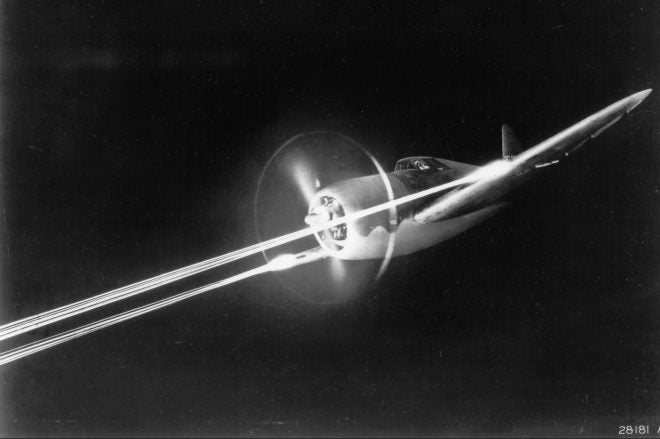As a researcher and history enthusiast, one of the issues I often have to wrestle with is that of eyewitness accounts, specifically when to trust them and when not to. That subject itself is one for another time, but today I want to look at a specific example of an eyewitness account as an illustration of how they can be misleading to someone trying to reconstruct historical events.
The account in question is this one, apparently from an unknown television documentary, in which a former P47 pilot describes attacking German tanks by bouncing bullets off the ground and into the underside of the tank’s hull:
Here are the basic facts as presented by the pilot’s account:
- He refers to the tanks as “Tigers”, probably referring to the PzKpfw. VI Tiger I
- He claims the tanks pulled fuel trailers, which the pilots would shoot at to ignite.
- If no trailer was present, the pilots would aim for the ground just before the tank to bounce bullets up to hit the bottom of the tank’s hull.
- He claims the bottom of the tanks’ hulls were not armored, but the top was.
Before I dig into this, I should say that even though I will prove the pilot’s account of events cannot be accurate, I am not calling him a “liar”. The unreliability of eyewitness testimony is extremely well established in the legal field, and this pilot is recalling events that happened many decades before the interview, so it is not just possible but entirely expected that his account will be riddled with errors.
The most obvious issue with the pilot’s testimony is his description of the tanks as “Tigers”, and his assertion that their hull floor was unarmored and easily penetrated by bouncing .50 cal projectiles. A quick look at a Tiger I’s armor diagram immediately raises questions about the validity of this description:
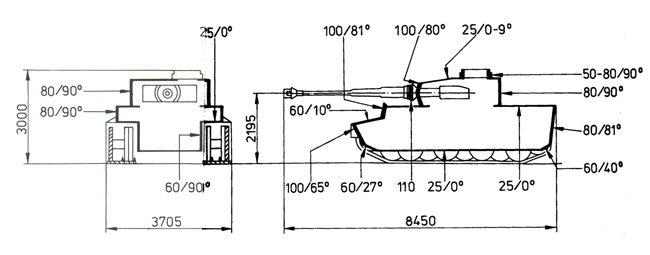
Image source: fprado.com. Note that these figures square with descriptions of the Tiger I’s protection on page 34 of Germany’s Tiger Tanks – D.W. to Tiger I: Design, Production & Modifications by Thomas L. Jentz & Hilary L. Doyle
As we can plainly see, the top and bottom hull armor plates on the Tiger I are exactly the same thickness, and the bottom is hardly “unarmored” as the pilot describes. If we compare this 25mm thickness to the penetration standard held for .50 cal M8 API (link starts a download) – the round in use with aircraft guns at the time – we see another discrepancy: M8 API does not seem to be potent enough to penetrate either plate!
A 7/8ths inch armor plate is just over 22mm thick, and nothing in the specification says that a 25mm plate couldn’t be penetrated, but we must also consider other factors. First, in an aerial attack, the horizontal plane of the tank would be presented at a very oblique angle; in the video we see an angle no greater than 45 degrees, and probably closer to 30 degrees, meaning the line-of-sight thickness of the armor plate would be at least 35mm and possibly as high as 50mm. This thickness, even without accounting for the disadvantage of attacking sloped armor, would be far too great for any steel cored .50 caliber projectile to perforate, even at 100m (far closer than any attack run should ever get!).
There are a couple other dimensions to this problem, however. One is the question: “Might bouncing the bullets off the ground present them at a more favorable angle to the armor?” The answer is that while the angle could perhaps be more favorable, the projectile post-ricochet would be unstable and relatively low energy, making a perforation of the plate even less likely than a head-on attack at the upper armor. Further, the top of the tank is home to the engine deck, the inlets for which can be vulnerable even to small arms fire.
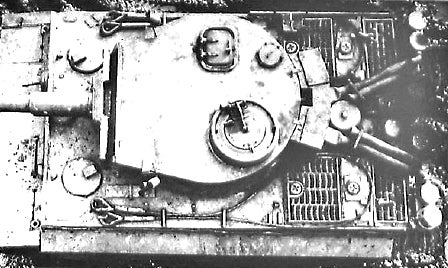
Note the large ventilation grates on the engine deck of this Tiger I Ausf. H1. Image source: tanks-encyclopedia.com
Then, it seems more likely that a .50 cal API round would penetrate the top deck of a Tiger I than the better-armored hull! Indeed, these additional details throw considerable doubt on the already somewhat far-fetched idea that pilots bounced rounds off the ground and into the hull floor. Further, I have to wonder whether the tanks these pilots were attacking were Tiger Is at all. The most immediate reason to think that they might not have been is that the Tiger I was a very rare tank on the Western Front, accounting for a very small fraction of German tanks, let alone armored fighting vehicles in general. Another, more compelling reason is that other German tanks had armor layouts that seem to work a little better with the pilot’s story (although there are still significant problems even so).
Let’s consider, for example, the Pzkpfw. IV Ausf. H, the primary variant of the Panzer IV that would have been in service with the Wehrmacht at the time of the European Theater:
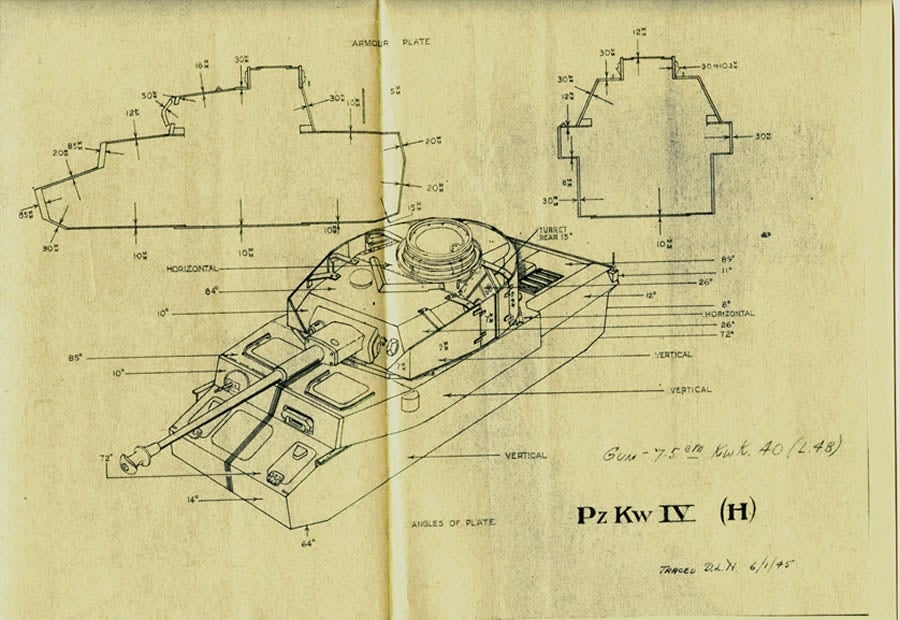
Image source: forum.worldoftanks.eu, from the book German tanks of World War II: The complete illustrated history of German armoured fighting vehicles, 1926-1945, by F. M. von Senger und Etterlin
Note that, unlike the Tiger I, the Panzer IV H possesses a large difference in armor between its top and bottom hull and turret, and appears to have much better overall coverage than the Tiger I due to smaller air intakes (feeding a much smaller and less powerful engine), albeit with generally thinner plates. The hull floor armor, I should point out, is a scant 10mm thick, raising at least some small possibility of penetration by ricocheting .50 cal AP projectiles. While the bouncing bullets story is still dubious, it at least makes some kind of sense if we assume Panzer IVs as targets instead of the notorious Tiger Is.
There is one other reason to believe that these may not have been “Tigers” after all, and that is the pilot’s reference to the tanks’ fuel trailers. The reason this is important is because it does not seem as though Tiger Is ever did pull petrol trailers; I can find no photographic evidence of or textual reference to them ever doing so, nor could any of the other people I asked when doing research for this post. If any of our readers have any evidence of Tiger Is being so equipped, please do let me know in the comments, but even so it does not seem like common practice, especially given the abundance of images of other tanks like the PzKpfw. IV and PzKpfw. 38(t) with fuel trailers.
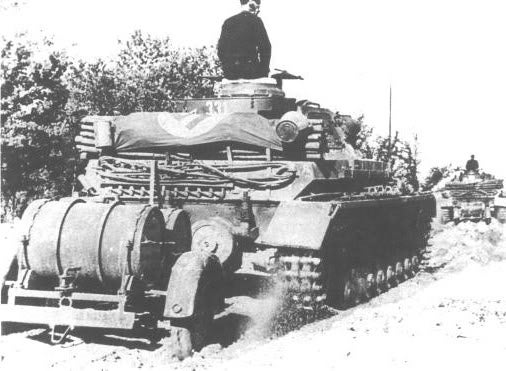
A Panzer IV tows a trailer with a couple of petrol drums. Image source: forum.axishistory.com
So then, what do we make of this account? Well, we can certainly say the man was a pilot, he did fly P-47s, and he surely did attack tanks or other armored vehicles on some occasions, but beyond that there isn’t much we can glean from his decades-old account. Like so many veterans’ accounts so distant from the events being recounted, there are numerous identifiable errors, making something like this not very useful for the history enthusiast seeking to reconstruct events as they were. This isn’t to say that we shouldn’t listen to veterans, of course – it should go without saying that we should! – but rather that a broader set of sources needs to be collected on a subject beyond just eyewitness testimony if an accurate picture is to be created, especially if that testimony is taken so long after the events in question actually occurred.
 Your Privacy Choices
Your Privacy Choices
